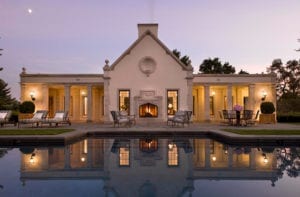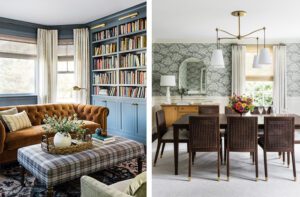A Historic Home in Brookline Gets a Fresh Look
November 13, 2017
With a bit of structural TLC and a fresh look inside, a venerable old colonial-style home near Boston adopts a youthful ambience.
Text by Maria LaPiana Photography by John Gruen Produced by karin Lidbeck Brent
The old house was down but not out. For starters, it was in very good company. It sat on a fully fenced lot in Cottage Farm, a designated historic district in Brookline, Massachusetts. The neighborhood boasts wide streets and sidewalks, a canopy of old-growth trees, and more than a few iconic residences.
The 5,000-square-foot colonial was “historically significant, with great bones,” says architect Robert Adams of Lexington. It was built in the early 1900s, in keeping with the vernacular architecture of Brookline, with a mix of stucco and wood shingle siding, a decorative asphalt shingle roof, shutters, a portico, and period windows. Over the years, however, an assortment of renovations had meddled with its authenticity and charm. It needed work.
That the house was open and bright appealed to the new homeowners, who were relocating from New York City. They liked that the neighborhood has an urban feel to it. And although the couple appreciated the home’s place in history, they entertain frequently and have two teenage sons, so they sought a fresh, casual, livable environment. Because they enjoy collecting art (the wife is an art historian), they wanted to be able to showcase their collection.
Adams, along with interior designer Kristen Rivoli, got the memo.
“Our goal was to bring the house back to its original glory,” says the architect. For her part, Rivoli set her sights on furnishing “fun, colorful, updated interiors with a laid-back, but elegant vibe.”
The public spaces needed TLC, but first there was some heavy lifting to do: An exterior facelift, a gut renovation of the kitchen to create a kitchen/eating area/pantry space, an overhaul of the first- and second-floor bathrooms, and the conversion of a sunroom into a family hub.
Adams made an interesting discovery early on. “I felt the design was clearly well conceived, but that there were some pieces missing. I consulted the historic commission and learned the original architect had his drawings archived at the Peabody Essex Museum. We found out that some critical windows had been removed, so we had them replicated, which completely changed the character of the house for the better.”
Once the home’s bones were set, Rivoli was ready to infuse its fresh new rooms with a heavy dose of what she calls “casual, urban chic.”
“First, we had to make the home comfortable,” the designer says. “The homeowners are very informal people who like to use every room. Then there was the art. They have some really great pieces that deserve to be highlighted, but I wanted to make sure it was a home—and not a museum.”
To that end, Rivoli relied on her clients’ sense of style and her talent for creating custom, contemporary spaces. “We wanted each room to have a distinctive, creative look but we didn’t want them to scream for attention and fight with one another,” she explains. Wherever possible, she reused the homeowners’ existing furniture, integrating new pieces throughout.
Rivoli designed plush area rugs—influenced by Craftsman and Prairie motifs—for the entry, dining room, family room, and master bedroom, a touch that elevates the spaces. “They really help to tie each room together and gave me an opportunity to add color and pattern,” she says.
She chose what she calls an “updated, understated, urban” palette. “I kept it neutral in the family room because there is a fabulous view outside. In the rooms where the focus is more inward, we added more color and pattern. We kept the existing natural wood and lightened painted finishes to brighten the rooms,” she says.
The home’s artful moments start at the front door. “The entry is very wide and long, but we didn’t want it to feel like a ‘pass through’ space,” says Rivoli. “We added benches, a side table, a console they had, and a great mirror.”
The view of the dining room from the entry was carefully framed. It’s one of the first rooms visible when the front door opens, and it’s on the path from the entryway to the kitchen and the rest of the house. “We wanted to make it colorful and striking in a modern sense,” says Rivoli. Abundant natural light spills in through a wall of windows onto dining chairs outfitted in a delicious cantaloupe hue that’s echoed in the graphic rug. “We reused the homeowners’ dining chairs and reupholstered them in a fresh fabric to work with the new color scheme,” the designer says.
The new kitchen is clean-lined and modern, with perimeter cabinets made by a millworker from Vermont and an island crafted from wormy chestnut salvaged from southern barn roofs. The scene-stealer in the kitchen may well be the highly striated countertops of Verde Bamboo granite that are often the first thing visitors comment on. An old, front-facing fireplace was converted to a raised corner gas fireplace that warms a banquette area, creating a cozy, informal dining space.
At first, the homeowners wanted the heavily paneled living room painted over, but Rivoli and Adams convinced them to highlight its beauty instead. A fabulous stitched-felt rug from their New York apartment plus a grasscloth wallcovering and new drapes and lighting complete the sophisticated look.
The sizable master bedroom proved a challenge. “We wanted to bring down the scale of the room,” says Rivoli. A custom rug under the bed gives definition to the space. An accent wall covered in playful chevron-patterned paper keeps the chinois drapes from looking overly formal.
The home’s original sunroom was transformed into a warm gathering space. “Because the ceiling was tilted and raised, I was able to use fun lanterns that really make the room stand out,” says Rivoli, pointing out the multi-faceted, frosted-glass fixtures. She ran a window seat around the perimeter of the room and added colorful, ethnic-inspired pillows. “We really all love to hang out there; it’s so bright and comfortable,” says the wife. “We actually weren’t even sure how we were going to use that space. But we worked with Kristen to make it a family room, and now it’s the most popular space in the house—besides the kitchen of course!”
Project Team
Architecture: Robert W. Adams, Robert W. Adams Architect
Interior design: Kristen Rivoli, Kristen Rivoli Interior Design
Builder: Brett Murphy, Murphy Construction Company
Landscape design: Richard Kattman
Share
![NEH-Logo_Black[1] NEH-Logo_Black[1]](https://www.nehomemag.com/wp-content/uploads/2022/08/NEH-Logo_Black1-300x162.jpg)


















You must be logged in to post a comment.